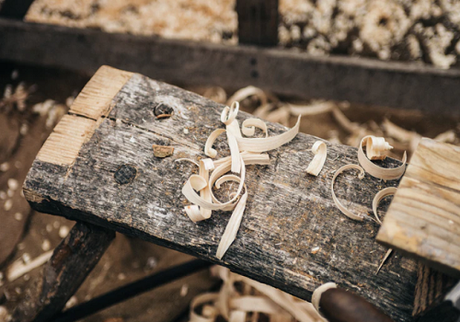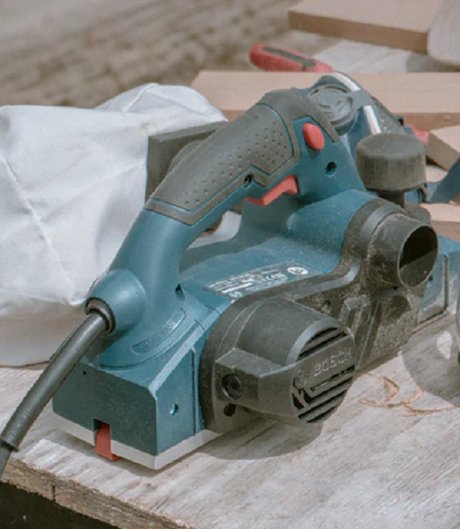According to the Independent, more than 18 million people consider themselves regular DIY shoppers, a big increase from the last years. That means people are fighting against excessive consumerism and are able to figure out problems by themselves, learning something new and getting that great rush of accomplishment along the way. The major setback in that way of thinking is the difficulty in finding the right tools for the job at hand.
When diving headfirst into the world of woodworking, it doesn’t matter if you’re just off the boat or if you can actually build one. There are so many tools and techniques out there, that you can always improve and learn more about the craft and, because sanding is one of woodworking’s most essential tasks, we’re here to help you in finding the perfect sander for you!

Stationary Sanders
Belt and Disc Sanders
These machines are made by a belt and a disc sander and are mainly used for surfacing and shaping. You can effortlessly smooth objects and quickly remove layers of material with ease due to their high powered motors. They’re mainly used for wood although with the right sanding belt and disc, they can also be used for plastics and even metals.
Though we’re not talking about a portable sander, these stationary machines are incredibly practical, as they offer a combination of a disc and a belt sander, in one tool which saves space, time and money. Imagine just sitting in a chair, working in your piece, totally focused, without having to get up and grab other tools. They differ in size – from medium to large – so you can choose the one that best fits your task and your available space.
Now, the disc uses sandpaper to do some rough shaping, touch up board ends, round off corners and sand small parts, always granting you great control. The belt offers you similar functions but due to its powerful nature, it’s often used to quickly sand down layers of rough material. If you go for the 1’’ (2.54cm) wide belts, you can only work with smaller materials, but you have the possibility of creating more curved and deeper areas. If you wish to sand larger boards and edges, you should check the 4’’ (10.2cm) belts, or even larger.
There’s a large variety of disc and belt sanders that excel at specific functions, but a rule of thumb is working the size and power ladder according to your experience in woodworking and the tasks you’ll be tackling as well.
Lastly, one of the best advantages of this machine is its simplicity. Just turn it on and slightly push the material against the disk, moving it from left to right. Remember, hard pressure is not required, let the sander do the work, instead!
Portable Sanders
This is a good tool to start with if you’re a beginner, as it combines an effortless and easy use with low value, even though some can be pretty powerful and reliable.
The big difference between the latter and this type of sander is the portability. For that reason, they’re usually lightweight and easy to maneuver. The biggest setback is that with a compact size comes less power and a larger difficulty in tackling big and hard surfaces but, on the other side, you won’t have to worry about ruining a piece by sanding it too much. If you do enjoy a clean and tidy workplace, some brands will also come with a dust collector but, if not, you can check out this list of the best ones on the market, at the moment.
Now, there’s a variety of portable sanders, but don’t worry, we’re here to help you choose the perfect one for you!
Palm Sanders
Also known as finishing sanders, they usually use squared or rectangular-shaped ¼ inch sandpaper – as a result of the smaller sandpaper, you might need to change it quite often (probably its major drawback).
They’re not made for a high polish finish or a tough job, but if you’ve got some tight corners and edges on smaller pieces you want to smooth out or old cabinets that need sanding, this is the perfect tool for the job! Due to its practicality and lightweight, you can use it with one hand, for large amounts of time, without having sore muscles or fatigue.
This might be the best option for the ones who are starting to get into woodworking because, on one side, is typically more economical than other sanders and, on the other side, it’s so easy to use – clamp the sandpaper using its clips, turn it on and sand away!
Belt Sanders
If you’re looking for an aggressive, multitasking tool, the belt sander (or strip sander) might be the one for you. We’re talking about a powerful machine that can deal with everything from small tasks as well as highly demanding ones, with its main use being shaping, finishing, large surface sanding and rough paint removal.
They will always be bigger than the previous type, varying from medium to large size, even though they are still pretty easy to handle.
Because of their wide sandpaper belts, you can take care of a large piece in a couple of minutes or a small project, effortlessly, without leaving marks and scratches. They can also be used for long amounts of time without having to switch their belt. Not recommended for beginners, as its power can wreck a project easily.
As to its grit, the rule of thumb is to start with an 80-grit and then change to a 120-grit as the project comes to an end. We also suggest using a cloth filter bag or a large vacuum system, as these bad boys can really make a mess.
Regarding safety measures, don’t push the sander, let its weight do the work, instead! This will also prevent scratches and give you a much smoother finish. Also, no changes in direction or speed and always pull the cord over your shoulder.

Disc Sanders
Disc sanders are, in a lot of ways, similar to the palm ones. They are extremely helpful machines that can really make a woodworking task into an effortless one.
Due to their spinning discs and their portability (various angles of action), ripping out old paint or linishing (remove excess material) becomes rather easy. Also, they can tackle smaller curved pieces as well as bigger flat surfaces, offering the same quality results in both cases, even though we wouldn’t recommend it for finishing highly delicate objects. Some brands are also capable of dealing with metal surfaces, even though there are additional safety measures, as sparks will fly all over the place.
A big advantage of these types of sanders is how easy you can use them. No manual needed – just turn it on, place it on the surface you want to work on and apply light pressure. To reduce scratches and poor finishes, we recommend holding the sander at a slight angle to the object, with around a third of the disk in contact, while keeping it in constant movement. The disk’s diameters will typically vary between four and eight inches (10 to 20cm).
Detail Sanders
These small machines are unique in the woodworking world and can bring a level of detail to your work that will greatly improve the final result and your overall technique. We don’t recommend buying as your first and main sander, as we’re talking about a specialized piece, suited for more experienced woodworkers.
The first aspects you’ll notice about detail sanders are their low weight, size, unique shape (perfect for taking on corners) and value, making them an effective hand-held tool and a bang for the buck! As we’ve mentioned, it has a unique triangular sanding pad tip (hence why they’re known as mouse sanders) that lets it reach pretty much anywhere with ease. When it vibrates, it’s capable of reaching tight spaces and difficult spots, otherwise impossible to sand – the main reason why they’re also known as “corner” sanders. You’ll see a lot of these tools used in restoring detailed and elegant furniture, opening the way to then finish or paint them. Their major setback is the lack of power compared with latter types, meaning it’s not suited for heavy stock removal.
If you think that, due to their size and shape, they can offer you an above-average convenience then imagine what you could do with a cordless one!
Random Orbital Sanders
These sanders are considered by a lot of woodworkers as one of the most essential tools in their arsenal. As its name states, the sandpaper not only moves in an orbital movement but also vibrates, meaning the abrasive material never goes through the same path twice, ensuring you a high-quality, spotless finish and leaving virtually no marks or patterns whatsoever. This type of movement also means that if the pad encounters some hard spot, it will maneuver around it and work bit by bit, in small orbits.
If you’re looking to get a fine-grit sanding (a shiny, elegant and polished finish) on a piece, there’s no better tool for it, as it effectively prepares the surface for the before and the after-painting. In terms of its pad diameter, there’s a large variety, meaning you can choose the one you want depending on the size of the projects you usually tackle. Similar to the other sanders, they’re best suited for wood and plastic, even though some brands can work pretty reliably with metal.
In Conclusion
There are many other types of sanders, but these ones are the most popular and versatile in the world of woodworking. Now that you’re more informed, there’s no excuse for not renovating that old furniture you’ve got lying around or giving a nice polish to your wooden floor. Thanks for reading and good luck – it’s time to get to work!

posted on 28 September at 11:30
Looking for a fume extractor system for laser marking, cutting or soldering processes? Need a solution to extract, absorb, and collect smoke generated by your workstations? Contact IP Systems 770-614-7701 Or Visit the website https://ipsystemsusa.com/.